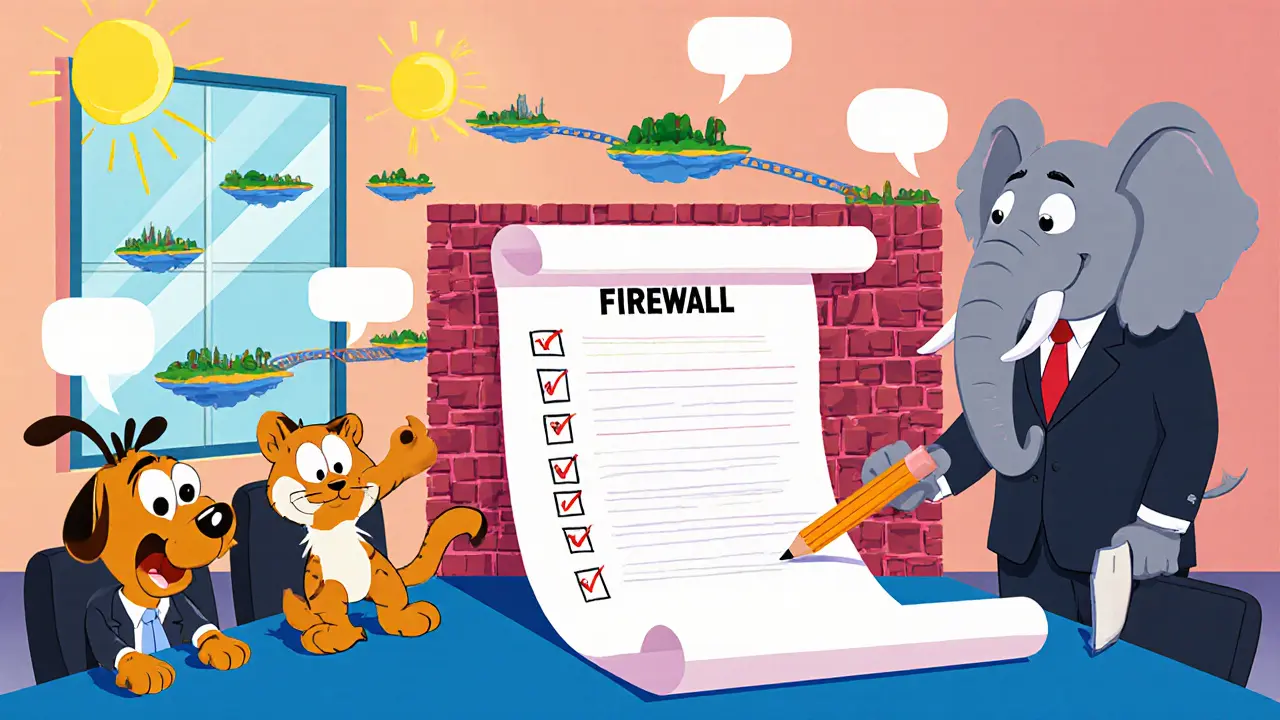Oracle EBS Vulnerability Risk Checker
Check Your Oracle EBS Version
Enter your Oracle E-Business Suite version to determine if it's affected by CVE-2025-61882 and receive tailored mitigation guidance.
Vulnerability Assessment Results
Recommended Immediate Actions
Enterprise leaders are waking up to a wave of high‑impact flaws that hit the heart of Oracle’s flagship applications. The most headline‑grabbing issue right now is CVE-2025-61882 a zero‑day vulnerability that lets attackers run code on Oracle E‑Business Suite servers without any credentials. If your organization runs any version of the suite between 12.2.3 and 12.2.14, you’re sitting on a ticking time bomb that could be detonated from the internet with a single HTTP request.
Why This Vulnerability Matters
The exploit chains together at least five distinct bugs inside Oracle Concurrent Processing the job‑scheduling engine of the E‑Business Suite. The result is a pre‑authenticated remote code execution (RCE) path that bypasses all traditional login checks. In practice, threat actors have already used the flaw in data‑extortion campaigns, stealing tables, encrypting files, and demanding ransom before Oracle even published its emergency advisory.
What the Numbers Tell Us
According to the official Critical Patch Update Oracle’s quarterly bundle of security fixes released in July 2025, nine security bugs hit the E‑Business Suite that year, three of them remotely exploitable without authentication. The April 2025 update for Oracle TimesTen In‑Memory Database a high‑performance cache used alongside the suite added two more unauthenticated RCEs. Patterns are clear: authentication bypass is becoming a recurring theme across Oracle’s product line.
Who’s Behind the Exploits?
Research from WatchTowr Labs an independent security firm that first released a functional proof‑of‑concept for CVE‑2025‑61882 suggests a high skill level. Their analysis shows a “dangerously fallen from a moving truck” scenario - the exploit was already circulating in underground markets before Oracle’s public alert. Whether it’s a state‑backed advanced persistent threat (APT) or a sophisticated cyber‑crime group, the payoff is obvious: Oracle environments store financial data, HR records, and supply‑chain details worth millions.

Immediate Risks for Your Organization
- Full system compromise with no user interaction needed.
- Potential data theft, ransomware, or manipulation of business‑critical processes.
- Compliance violations for industries that require strict data protection (e.g., finance, healthcare).
- Unplanned downtime while emergency patches are applied.
Short‑Term Defensive Actions
Time is of the essence. Follow this checklist to lock down exposed assets while you await a permanent patch.
| Action | Priority | Owner |
|---|---|---|
| Block external HTTP access to Oracle E‑Business Suite front‑ends | Critical | Network Team |
| Apply the emergency patch released in Oracle’s Saturday advisory | Critical | DBA Team |
| Enable multi‑factor authentication for all admin accounts | High | Security Ops |
| Conduct a focused log review for unusual concurrent processing jobs | Medium | SOC |
| Update asset inventory to flag all 12.2.3‑12.2.14 instances | High | IT Asset Management |
Long‑Term Strategies to Reduce Future Exposure
Even after the patch lands, a broader security program is required to keep Oracle’s complex stack safe.
- Network Segmentation: Keep Oracle databases and middleware on isolated VLANs, limiting the blast radius of any breach.
- Regular Patch Management the practice of applying vendor security updates on a defined schedule: Move from quarterly Critical Patch Updates to a continuous monitoring model that can ingest emergency advisories immediately.
- Application‑Level WAF Rules: Deploy signatures that detect the specific HTTP payload patterns used by the CVE‑2025‑61882 exploit chain.
- Security‑by‑Design Reviews: Conduct architecture reviews that focus on authentication bypass vectors across the Oracle Fusion Middleware, Database, and E‑Business Suite layers.
- Threat Hunting: Use the indicators of compromise (IOCs) shared by WatchTowr Labs to scan logs for signs of prior exploitation.

Understanding the Bigger Picture
Oracle’s market share means its software is a high‑value target. The repetitive nature of authentication‑related bugs points to systemic design challenges. As more companies adopt cloud‑native extensions and integrate Oracle with third‑party SaaS tools, the attack surface only widens. Keeping pace requires a blend of rapid patching, deep visibility, and a zero‑trust mindset that assumes any component could be compromised.
Key Takeaways
- Oracle security is under pressure: CVE‑2025‑61882 proves that unauthenticated RCEs are no longer theoretical.
- Immediate patching and network isolation are the only ways to stop active exploitation.
- Long‑term resilience demands continuous patch management a disciplined approach to applying vendor fixes, segmentation, and threat‑hunts.
- Stakeholders-from DBAs to C‑suite execs-must treat Oracle vulnerabilities as business‑critical incidents.
- Future Oracle releases are likely to include more authentication bypass fixes; stay ahead by monitoring official advisories.
Frequently Asked Questions
What versions of Oracle E‑Business Suite are affected by CVE‑2025‑61882?
All releases from 12.2.3 up to and including 12.2.14 are vulnerable. Earlier major releases are not impacted, but administrators should still verify their patch level.
How can I tell if my system has already been compromised?
Look for unexpected concurrent processing jobs, new system users, or outbound traffic to unknown IPs. WatchTowr Labs published specific IOC hashes that can be fed into SIEM tools for automated detection.
Is there a workaround until the official patch is applied?
The only reliable temporary mitigation is to block all inbound HTTP/HTTPS traffic to the E‑Business Suite frontend from the internet and enforce strict IP allow‑lists. This won’t stop internal attackers but stops the most common attack vector.
Will future Oracle patches address the root cause of authentication bypass?
Oracle has pledged to improve its secure‑coding practices, but given the complexity of the suite, new bypasses are likely to appear. Continuous monitoring of Oracle’s Critical Patch Updates is essential.
How does the vulnerability affect compliance frameworks like PCI‑DSS or GDPR?
Unauthenticated RCE can lead to unauthorized access to cardholder or personal data, constituting a clear violation of PCI‑DSS and GDPR breach reporting requirements. Organizations must document the incident and may need to notify regulators within 72 hours.

I've been pondering the broader implications of the Oracle EBS zero‑day, and it seems like a wake‑up call for every organization that relies on legacy enterprise stacks. The fact that unauthenticated RCE can be triggered through the concurrent processing engine hints at deeper design assumptions that may no longer hold in a zero‑trust world. While the emergency patch is essential, we should also reconsider how we segment these workloads and enforce strict network boundaries. In practice, a layered defence-using firewalls, waf‑rules, and vigilant monitoring-can dramatically reduce the attack surface. Moreover, aligning patch cycles with a continuous monitoring approach ensures we aren't waiting for quarterly releases to address critical flaws. It’s also worth noting that many compliance frameworks now treat unpatched software as a material risk, so the financial implications go beyond direct remediation costs. Ultimately, the community needs to share concrete mitigation stories to build a resilient posture against future Oracle‑related exploits.
Wow!!! This is exactly why you should always keep your systems up‑to‑date!!! The Oracle team finally released a patch, but you still have to block those external HTTP requests right now!!! If you don’t act fast, you’ll be the next headline!!!
Guys, this is the kind of drama that keeps us on the edge of our seats! The exploit chain is like something straight out of a cyber‑thriller novel-five bugs dancing together to let a hacker waltz right into our databases. I love how the community rallied so quickly to dissect the proof‑of‑concept and share IOCs. It shows the power of collaborative security research. Still, it feels like the vendors are always a step behind, publishing patches after the damage is already done. For those of us watching the clock tick, every minute counts. Let’s keep the conversation going and make sure we’re all on the same page with mitigations.
Honestly, I think the hype around this zero‑day is a bit overblown. Sure, it’s a serious issue, but many companies have already implemented network segmentation that would block the exploit anyway. Instead of panicking, we should focus on the basics: good patch hygiene and proper firewall rules. It’s not rocket science.
hey folks, just wanna say that i checked our ebs version and we’re good for now. still, im setting up a quick block on the front‑end ports just to be safe. nothing fancy, just a simple iptables rule.
It is absolutely unacceptable that organizations continue to run vulnerable Oracle instances without immediate remediation. The moral responsibility lies with the IT leadership to protect customer data and uphold regulatory standards. Delaying patches is tantamount to negligence, and any breach resulting from this oversight will be a direct consequence of willful ignorance.
Indeed, the aforementioned stance reflects a profound misapprehension of risk management protocols; consequently, the failure to institute comprehensive defensive measures constitutes a breach of fiduciary duty. Moreover, the reliance on ad‑hoc firewall adjustments without a formal change‑control process is emblematic of systemic governance deficiencies. It is imperative that organizations adopt a rigorous, documented patch‑management framework, thereby ensuring compliance with ISO 27001 and related standards.
The extensive analysis presented in the advisory highlights several critical facets that merit thorough discussion. Firstly, the authentication bypass inherent in the concurrent processing component underscores a systemic flaw in Oracle's session validation mechanisms, which appears to have persisted across multiple release cycles. Secondly, the exploit's reliance on a crafted HTTP payload demonstrates that traditional perimeter defenses, such as basic firewall rules, are insufficient without deep packet inspection capabilities. Thirdly, the rapid proliferation of the proof‑of‑concept across underground forums suggests an elevated level of operational maturity among threat actors targeting enterprise resources. Fourthly, organizations must not only apply the immediate emergency patch but also reevaluate their network segmentation strategies to isolate EBS front‑ends from untrusted networks. Fifthly, implementing multi‑factor authentication for administrative accounts can mitigate the impact of any subsequent credential‑based attacks. Sixthly, continuous monitoring of log files for anomalous concurrent job submissions can serve as an early warning indicator of exploitation attempts. Seventhly, leveraging threat‑intelligence feeds that provide specific IOC signatures for this vulnerability will enhance detection efficacy within SIEM platforms. Eighthly, regular tabletop exercises that simulate a breach scenario involving this RCE can improve incident response readiness. Ninthly, a comprehensive asset inventory that tags all instances of Oracle EBS, especially those within the vulnerable version range, is essential for accurate risk assessment. Tenthly, organizations should consider adopting a zero‑trust networking model, thereby limiting lateral movement opportunities for attackers who may compromise a single component. Eleventhly, the recurring theme of authentication bypass across Oracle products signals a need for the vendor to invest in deeper security code reviews during development. Twelfthly, the integration of Oracle Fusion Middleware and third‑party SaaS solutions expands the potential attack surface, necessitating additional security controls at those integration points. Thirteenthly, compliance implications are non‑trivial; failure to address this vulnerability could result in violations of PCI‑DSS, GDPR, and other regulatory frameworks, leading to fines and reputational damage. Fourteenthly, the vendor’s advisory timeline demonstrates a lag between vulnerability discovery and public disclosure, which emphasizes the importance of proactive threat hunting. Finally, an overarching recommendation is to cultivate a culture of security awareness across all stakeholder groups, ensuring that both technical and non‑technical teams understand the urgency and scope of this issue.
There's a pattern here that the mainstream security community often overlooks. The same group of shadowy actors seems to have insider knowledge of Oracle's development pipeline, which raises unsettling questions about supply‑chain infiltration. When a zero‑day like CVE‑2025‑61882 surfaces so quickly after the code freeze, one has to wonder whether the vulnerability was intentionally left unpatched or perhaps even introduced. This isn't just about a single RCE; it's about the potential for a broader campaign that could target multiple Oracle applications simultaneously. If we keep assuming these are isolated incidents, we might miss the connective tissue that binds them together, allowing a larger, coordinated attack to unfold unchecked. It's critical to expand our threat models to include the possibility of state‑sponsored actors leveraging these footholds for espionage or economic disruption. The stakes are higher than just patching an exploit; they're about safeguarding the integrity of global enterprise ecosystems.
Please remember that while the technical details are daunting, the human factor is equally crucial. Encourage your teams to double‑check firewall rules, verify patch deployment, and maintain clear communication channels. A calm, methodical approach will reduce errors and improve overall resilience.
Thanks for the reminder! 🙏 Keeping the team in the loop and staying cool under pressure really makes a difference. 😊
From a cultural perspective, it's essential to recognize that many organizations still view Oracle as a legacy system, and that mindset can delay proactive security measures. By fostering an environment where continuous improvement is celebrated, we can shift the narrative from "we're stuck with this" to "we're evolving our security posture together". Simple, clear communication and shared responsibility can bridge the gap between technical teams and executive leadership.
Let me break it down for everyone: the vulnerability exists because Oracle's codebase is massive and often lacks thorough peer review. This isn't a surprise; large enterprises frequently have hidden doors. The patch is a band‑aid, not a cure. We need to audit the entire stack, enforce strict change control, and push for open‑source scrutiny where possible. Otherwise, we'll keep chasing these bugs forever.
Great summary! Indeed, continuous monitoring and community collaboration are the keys to staying ahead of these threats!!!
Let's remember that effective security is a team sport. Share the remediation steps with all stakeholders, from DBAs to C‑suite executives, and make sure everyone understands both the urgency and the long‑term benefits of a hardened environment.
Got it, we’ll get on it ASAP.